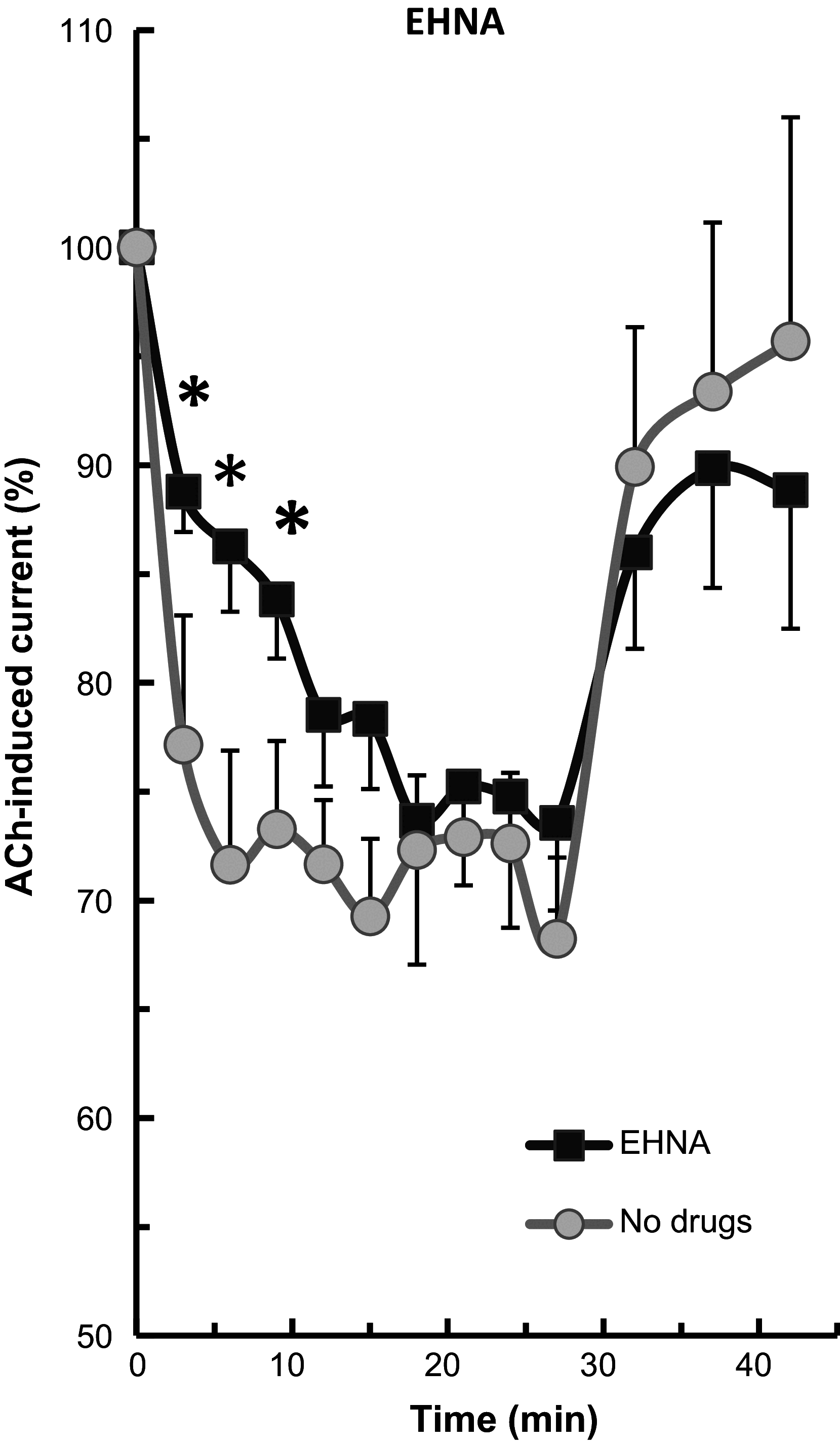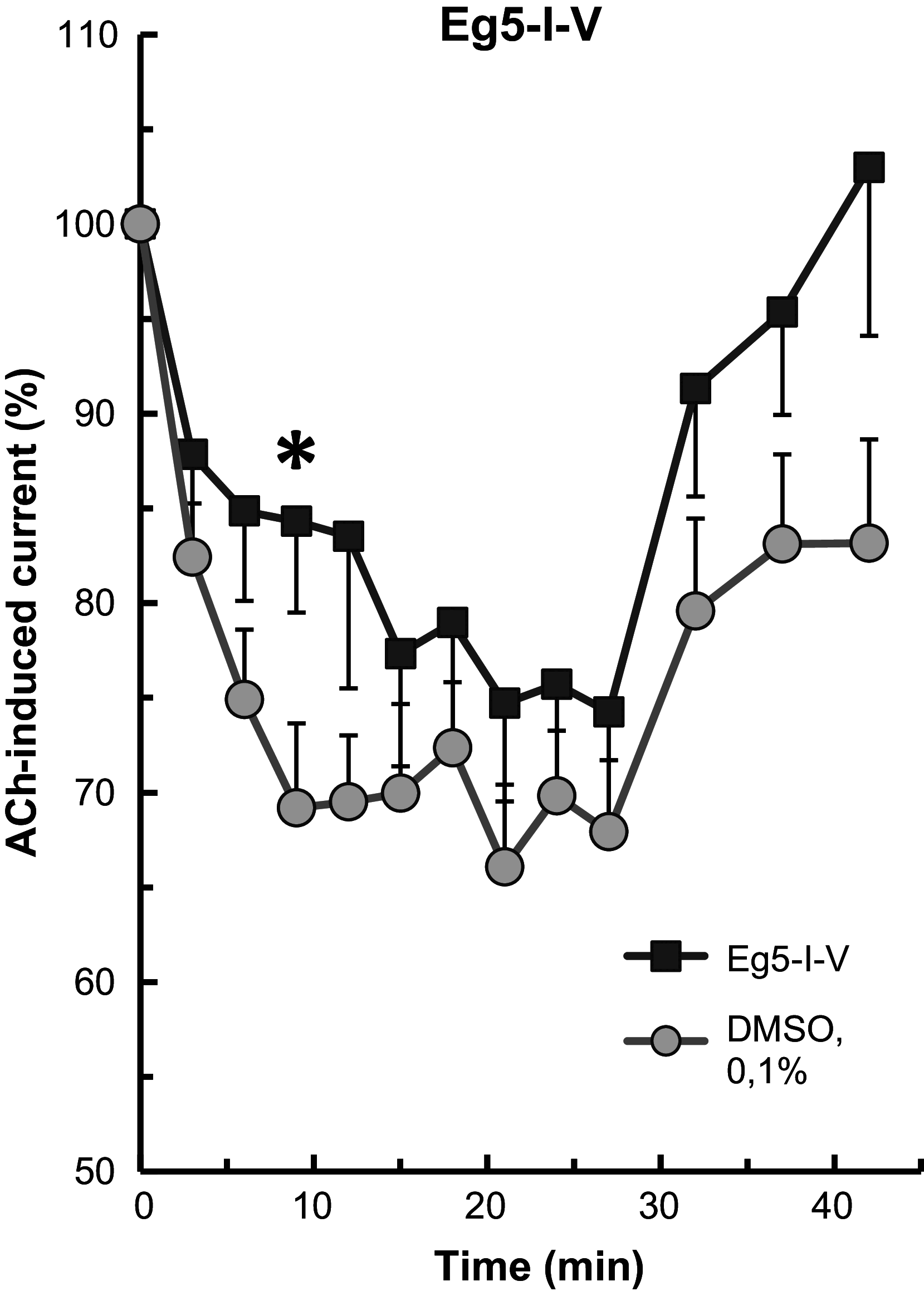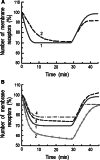Habituation-Like Decrease of Acetylcholine-Induced Inward Current in Helix Command Neurons: Role of Microtubule Motor Proteins
- PMID: 25687906
- PMCID: PMC11486294
- DOI: 10.1007/s10571-015-0165-y
Habituation-Like Decrease of Acetylcholine-Induced Inward Current in Helix Command Neurons: Role of Microtubule Motor Proteins
Abstract
The role of kinesin and dynein microtubule-associated molecular motors in the cellular mechanism of depression of acetylcholine-induced inward chloride current (ACh-current) was examined in command neurons of land snails (Helix lucorum) in response to repeated applications of ACh to neuronal soma. This pharmacological stimulation imitated the protocol of tactile stimulation evoking behavioural habituation of the defensive reaction. In this system, a dynein inhibitor (erythro-9-(2-hydroxy-3-nonyl)adenine, 50 µM) decreased the ACh-current depression rate. Kinesin Eg5 inhibitors (Eg5 inhibitor III, 10 µM and Eg5 inhibitor V, trans-24, 15 µM) reduced the degree of current depression, and Eg5 inhibitor V also reduced the initial rate of depression. The results of electrophysiological experiments in combination with mathematical modelling provided evidence of the participation of dyneins and kinesin Eg5 proteins in the radial transport of acetylcholine receptors in command neurons of H. lucorum in the cellular analogue of habituation. Furthermore, these results suggest that the reciprocal interaction between dynein and kinesin proteins located on the same vesicle can lead to reverse their usual direction of transport (dyneins-in exocytosis and kinesin Eg5-in endocytosis).
Conflict of interest statement
The authors declare that there is no conflict of interest.
Figures





Similar articles
-
Mobility of acetylcholine receptors in command Helix lucorum neurons in a cellular analog of habituation.Invert Neurosci. 2013 Dec;13(2):135-50. doi: 10.1007/s10158-013-0155-z. Epub 2013 Apr 17. Invert Neurosci. 2013. PMID: 23591591
-
[The role of serine/threonine and tyrosine protein kinases in the depression of cholinosensitivity in Helix lucorum neurons in the cellular correlate of habituation].Zh Vyssh Nerv Deiat Im I P Pavlova. 2011 Jul-Aug;61(4):459-75. Zh Vyssh Nerv Deiat Im I P Pavlova. 2011. PMID: 21961321 Russian.
-
[Endocytosis of cholinoreceptors in the mechanism of depression of cholinosensitivity in Helix lucorum neurons in a cellular model of habituation].Zh Vyssh Nerv Deiat Im I P Pavlova. 2010 Mar-Apr;60(2):206-16. Zh Vyssh Nerv Deiat Im I P Pavlova. 2010. PMID: 20469596 Russian.
-
Moving on to the cargo problem of microtubule-dependent motors in neurons.Curr Opin Neurobiol. 2000 Oct;10(5):566-73. doi: 10.1016/s0959-4388(00)00129-x. Curr Opin Neurobiol. 2000. PMID: 11084318 Review.
-
Regulation of molecular motor proteins.Int Rev Cytol. 2001;204:179-238. doi: 10.1016/s0074-7696(01)04005-0. Int Rev Cytol. 2001. PMID: 11243595 Review.
Cited by
-
Responses of Withdrawal Interneurons to Serotonin Applications in Naïve and Learned Snails Are Different.Front Cell Neurosci. 2017 Dec 14;11:403. doi: 10.3389/fncel.2017.00403. eCollection 2017. Front Cell Neurosci. 2017. PMID: 29311833 Free PMC article.
-
Intranasal Delivery of Recombinant NT4-NAP/AAV Exerts Potential Antidepressant Effect.Neurochem Res. 2016 Jun;41(6):1375-80. doi: 10.1007/s11064-016-1841-0. Epub 2016 Feb 4. Neurochem Res. 2016. PMID: 26846142
-
Report on the 13th symposium on invertebrate neurobiology held 26-30 August 2015 at the Balaton Limnological Institute, MTA Centre for ecological research of the Hungarian Academy of Sciences, Tihany, Hungary.Invert Neurosci. 2016 Jun;16(2):3. doi: 10.1007/s10158-016-0186-3. Invert Neurosci. 2016. PMID: 27149972
References
-
- Abramova MS, Makhnovskii DA, Pivovarov AS (2007) Role of cholinoceptors recycling in short-term potentiation of cholinosensitivity of command neurons in edible snail. Bull Exp Biol Med 144:276–279 - PubMed
-
- Collingridge GL, Isaac JT, Wang YT (2004) Receptor trafficking and synaptic plasticity. Nat Rev Neurosci 5:952–962 - PubMed
Publication types
MeSH terms
Substances
LinkOut - more resources
Full Text Sources

